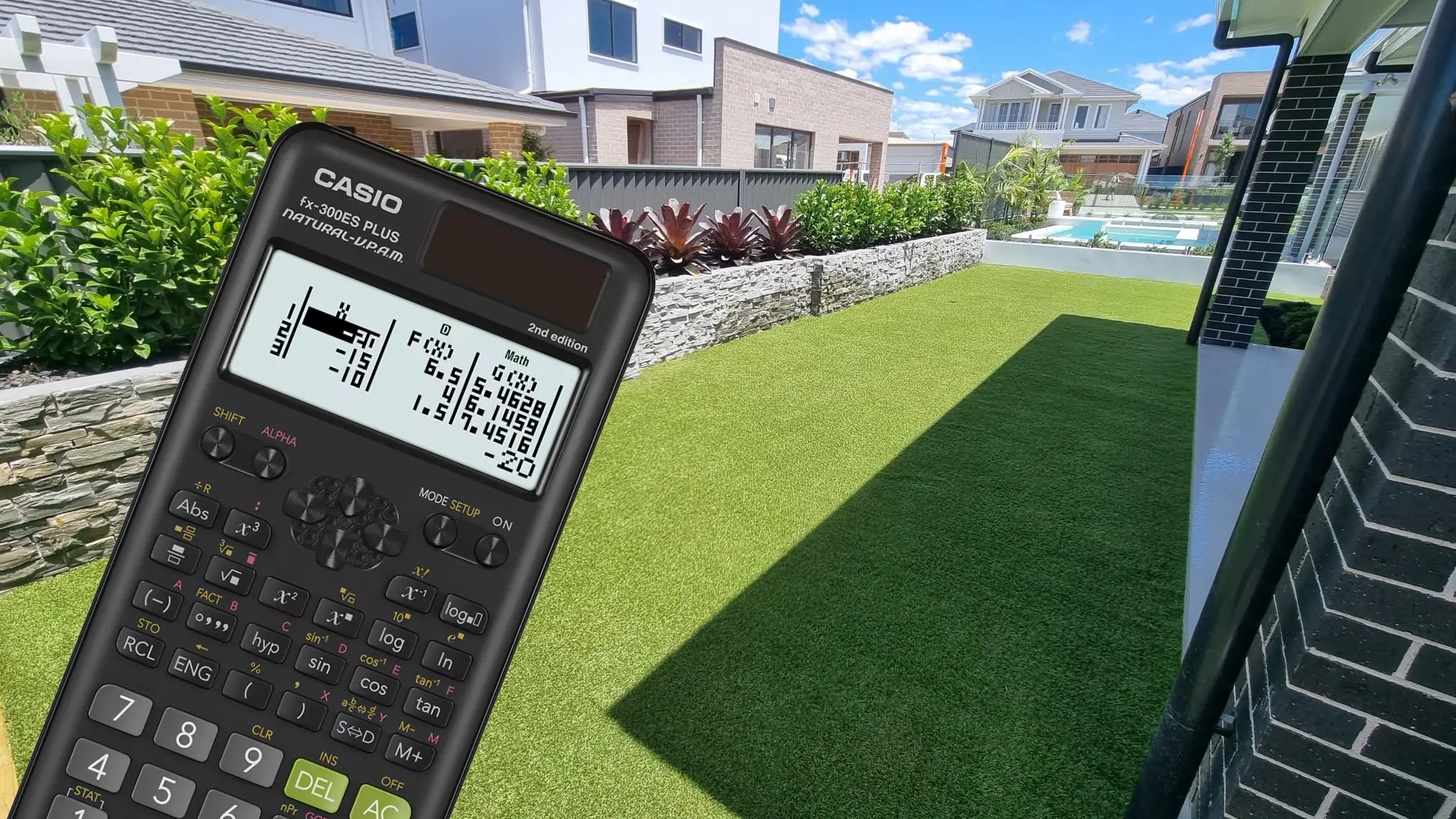Measuring for artificial grass involves calculating the total square footage of your area by multiplying its widest and longest points. For irregular shapes, divide the area into manageable rectangles and squares, calculate each one, and add them together. Always add 10% for waste and cuts.
How Do I Calculate How Much Artificial Grass I Need?
To calculate how much artificial grass you need, measure the longest and widest parts of your lawn in metres. Multiply these two numbers to get the total square metreage. Because turf comes in fixed roll widths, you must plan your cuts to minimise waste, always adding about 10% to your final number to be safe.
Artificial Grass Calculator
Calculate exactly how much artificial grass you need for your project
• Always measure the widest and longest points of your area
• For L-shaped or irregular lawns, divide into rectangles and calculate each
• Plan your seam placement to minimise visible joins
• Ensure all pieces have grass grain facing the same direction
Try This Now
Immediate Action Items:
- Walk Your Lawn: Identify the absolute widest and longest points of the area.
- Use the Calculator Above: Plug in your two measurements to get an instant base estimate.
- Sketch Your Area: Draw a rough shape of your lawn on paper. This is the first step for an accurate plan.
The 3-Step Method for Measuring Any Lawn
To measure your lawn, first sketch its shape and mark the longest and widest points. Then, use a tape measure to get these two key dimensions. Finally, break any irregular shapes down into smaller squares or rectangles to calculate the area of each one individually.
Step 1: Sketch Your Lawn & Find the Max Dimensions
- Use graph paper or a notepad
- Draw the basic shape of your installation area
- Even if it’s curved, treat it as if it fits inside a large rectangle
- Measure the total width and length of this rectangle
Step 2: Measure Simple Shapes (Squares & Rectangles)
For square or rectangular lawns, simply multiply the Width × Length to get your total square metreage.
Example: A 6m wide by 10m long area needs 60 sq. m of turf.
Step 3: Measure Irregular & L-Shaped Lawns
The “Divide and Conquer” Method: Break your complex shape into multiple, smaller rectangles or squares.
Instructions:
- On your sketch, draw lines to divide the lawn into regular shapes
- Measure the length and width of each individual shape
- Calculate the square metreage for each shape (Area = L × W)
- Add all the individual totals together for your final number
Self-Check Method: Double-check your measurements. It’s recommended to measure everything twice to avoid simple errors.
Troubleshooting Guide
Common Mistake: Forgetting to account for fixed roll widths.
Solution: Always plan your cuts based on the roll width (usually 4m or 5m) to minimise seams and waste. Your layout plan is as important as the total square metreage.
Common Mistake: Not ordering extra for waste.
Solution: Always add 5-10% to your final calculation to account for cuts, angles, and potential mistakes.
What Size and Width Does Artificial Grass Come In?
Artificial grass is most commonly sold in standard roll widths of 2 metres, 4 metres, and 5 metres in Australia. The length of the roll can typically be cut to your specific needs.
| Roll Width | Best For | Key Takeaway |
|---|---|---|
| 2m | Smaller gardens, balconies, narrow side yards, or projects where multiple pieces can be easily joined | Using narrower rolls on a wide garden will create more seams. Planning is crucial. |
| 4m | Medium-sized gardens and areas where you want to balance between seam quantity and manoeuvrability | This width offers good flexibility for most residential projects. |
| 5m | Most standard residential lawns, larger gardens, and areas where you want to minimise the number of visible seams for a cleaner look | This is the widest common width and often leads to less waste on larger projects. |
Real-World Application
If your garden is 6 metres wide, you cannot buy a 6-metre roll. You will need to buy one 5-metre wide roll and a separate 1-metre wide cut, requiring a seam. Alternatively, you could lay two 4-metre wide pieces side-by-side and have more initial waste but a potentially better grain direction.
You’ve Measured. What’s Next?
- Finalise Your Sketch: Draw your final measurement plan, including where the turf rolls will be placed and where seams will go.
- Confirm Grain Direction: All pieces of artificial grass must be installed with the fibres (grain) pointing in the same direction to avoid a patchy look. Factor this into your layout.
- Request a Quote: Use your final square metreage (including the 10% overage) to request an accurate price from Classic Backyards.
Final Tips for Success
Remember that accurate measurement is the foundation of a successful artificial grass installation. Taking the time to measure carefully, plan your layout, and account for the fixed widths of artificial grass rolls will save you both time and money. Whether you’re covering a simple rectangular lawn or tackling a complex garden shape, following these steps will ensure you order the right amount of turf for your project.
Don’t forget to factor in any obstacles like garden beds, trees, or pathways when calculating your measurements. These areas will need to be cut around, which may affect how you position your rolls to minimise waste.
With your measurements complete and your plan in hand, you’re ready to transform your outdoor space with beautiful, low-maintenance artificial grass that will look fantastic year-round in the Australian climate.
